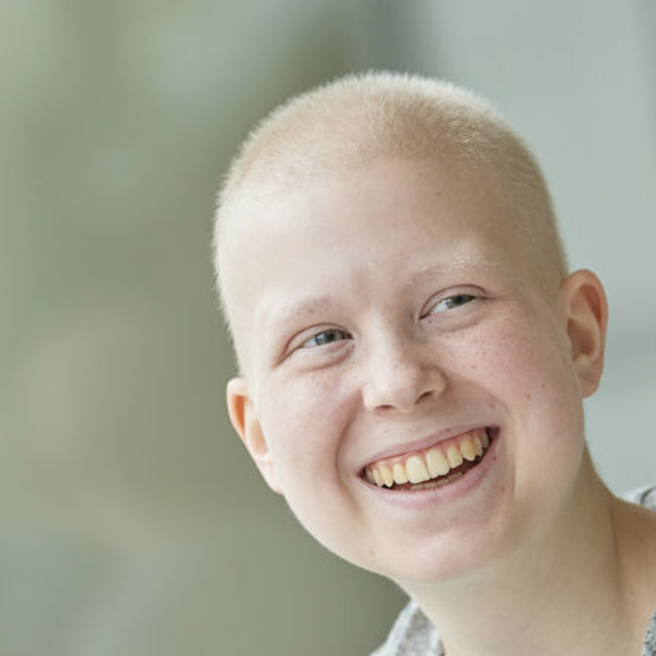What is rhabdomyosarcoma?
Rhabdomyosarcoma in children is a rare cancer but is the most common type of soft tissue sarcoma (a tumor that is malignant, or that spreads).
Rhabdomyosarcomas are comprised of primitive muscle cells. These tumors can form anywhere in the body, including the structures of the head and neck, the arms and legs, and the genitourinary system, which includes the bladder, prostate, vagina/uterus, and testis.
Most rhabdomyosarcoma cases are diagnosed in the first 10 years of life. The majority of children with rhabdomyosarcoma have no known risk factors. Some children with certain inherited conditions are at increased risk for the disease, and some families have a gene mutation that increases risk.
Causes of rhabdomyosarcoma in children
Rhabdomyosarcoma is caused by genetic changes in tumor cells. One type of rhabdomyosarcoma, called alveolar rhabdomyosarcoma, is caused by a translocation, where two chromosomes “swap” small pieces of each other. The result is an abnormal gene that can be detected with DNA testing. The other type of rhabdomyosarcoma is caused by other kinds of genetic changes. Your doctor will evaluate these genetic changes to determine the type of rhabdomyosarcoma you child has and to decide on the best treatment approach.
In most patients, it is not known why these genetic changes occur, and they can’t be passed from parent to child. In rare cases, an increased risk of rhabdomyosarcoma has been linked to genetic mutations that are familial (passed down from parent to child).
Signs and symptoms of rhabdomyosarcoma in children
Symptoms of rhabdomyosarcoma vary depending on the location of the tumor. For example, tumors in muscle may appear as a painful lump and may be mistaken for an injury. Tumors in the nose or throat may cause bleeding, swallowing problems or congestion. Tumors in the vagina may appear as a visible mass extending from the vagina. Bladder and vaginal tumors may cause urinary or bowel obstruction. Other genitourinary tumors can cause difficulty urinating, blood in the urine, abdominal pain, back pain, vaginal bleeding, or a mass or swelling.
Diagnosis often takes time, either because of a lack of clear-cut symptoms or symptoms that mimic injuries.
Testing and diagnosis for rhabdomyosarcoma in children
Diagnosing rhabdomyosarcoma requires a careful and complete medical workup and examination of your child.
At Children’s Hospital of Philadelphia (CHOP), clinicians use a variety of diagnostic tests to correctly identify rhabdomyosarcoma in your child, including:
- Magnetic resonance imaging (MRI), which uses a combination of large magnets, radiofrequencies and a computer to produce detailed images of organs, soft tissues, muscles, ligaments and other structures within the body. Your child is exposed to no radiation during an MRI.
- Needle biopsy, which is a procedure where a doctor places a small needle through the skin and into the lesion to withdraw a small sample of the abnormal tissue. The tissue is analyzed to confirm any findings.
- Computed tomography (CT) scan, which uses a combination of X-rays and computer technology to produce cross-sectional images ("slices") of the body.
- Bone marrow biopsy, which is a procedure where a doctor places a small needle into the bone and withdraws a small sample of tissue. The tissue is analyzed to determine if the cancer has spread.
- Positron emission tomography (PET) scan, which uses radioactive sugar injected into a vein and a scanner to make detailed, computerized pictures of areas of the body.
- Spinal tap (lumbar puncture), which is a procedure where a doctor places a small needle into the spinal cord in the lower back and withdraws a small sample of tissue. The tissue is analyzed to determine if the cancer has spread to the brain.
Treatment for rhabdomyosarcoma in children
There are many treatment options available for soft tissue tumors like rhabdomyosarcoma, including chemotherapy, surgery, and radiation therapy. Most children with rhabdomyosarcoma will need a combination of these therapies. At CHOP, experts at the Bone and Soft Tissue Tumor Program collaborate with specialists such as urologists and radiation oncologists, depending on the tumor’s location, to provide your child with individualized care and the best possible outcomes.
Your child’s care team may include nationally renowned surgeons who specialize in performing limb-sparing surgery or organ-sparing surgery, as well as reconstructive surgery.
Chemotherapy
In addition to treatment of the primary tumor, almost all children with rhabdomyosarcoma will require treatment with chemotherapy to target cancer cells that may have already spread but have not yet been detected. Chemotherapy refers to medicines that help fight cancer.
In most cases, chemotherapy is given to your child through an implantable venous port in the chest. The port remains in place for the duration of therapy to help your child avoid multiple needle sticks.
The specific chemotherapy regimen that is recommended will depend on the type of rhabdomyosarcoma that your child has and where it is located in the body.
Local Control
There are two options that may be used alone or together to treat the primary tumor: surgery and radiation therapy. We use a multidisciplinary approach to determine which option is best for each patient based on the location of their tumor.
Surgery
Surgery is often recommended for rhabdomyosarcoma in children. Our surgeons will remove the cancer using the most advanced surgical techniques available.
The goals of surgery are twofold:
- To remove the tumor
- To restore function at the site of the tumor
Limb-sparing surgery
Most children with rhabdomyosarcoma of an extremity can be treated with limb-sparing (also known as limb-salvage) and reconstructive surgery. CHOP surgeons regularly perform these complex surgeries and are constantly working to improve outcomes for children with the most difficult-to-treat tumors.
Limb-sparing surgery is performed under general anesthesia. It involves cutting out the tumor and a margin of health tissue surrounding it. Depending on the size and location of the tumor, as well as your child’s age and stage of growth, orthopedic and plastic surgeons may use a variety of reconstructive methods to restore your child’s body function. Reconstructive surgery, if necessary, will occur on the same day the tumor is removed.
Reconstruction may include:
- Skin graft, in which a doctor removes skin from the child’s own thigh or buttocks to use it to cover and protect the area where the tumor was removed
- Rotational muscle or fasciocutaneous flap, in which a doctor uses a child’s own muscle or skin near the surgery site, and rotates it to fill the area where the tumor was removed to provide a soft-tissue reconstruction
- Free muscle or fasciocutaneous flap, in which a doctor uses muscle or skin from the child’s own body, relocates it, and then reconnects the blood vessels to the tissue that was moved in the area where the tumor was removed
- A free bone flap, in which a piece of bone from a donor site is moved, based on its blood supply, to reconstruct the bony defect
In extremely rare cases — because of the size or location of the tumor — rhabdomyosarcoma cannot be removed with limb-sparing surgery. In these rare situations, it may be necessary to perform an amputation of the affected limb.
After limb-sparing surgery for rhabdomyosarcoma, your child should expect to stay two to five days in the hospital.
Organ-sparing surgery
The majority of children with rhabdomyosarcoma of a genitourinary organ can be treated with organ-sparing and reconstructive surgery. CHOP surgeons regularly perform these complex surgeries and are constantly working to improve outcomes for children with the most difficult-to-treat tumors.
The initial surgery includes a diagnostic biopsy of the mass or complete tumor removal to confirm and further define the extent of tumor.
Organ-sparing surgery is performed under general anesthesia. It involves removal of the tumor and a margin of healthy tissue surrounding it. Depending on the size and location of the tumor, as well as your child’s age and stage of growth, urologic surgeons may use a variety of reconstructive methods to restore your child’s body function.
Reconstructive surgery, if necessary, may occur at a later date after the tumor is removed and your child has recovered from cancer treatment. The type of reconstruction depends on what genitourinary organ (either whole or in part) has been removed and can include bowel, skin or lip graft or catheterizable urinary bowel pouch.
For rhabdomyosarcoma of the genitourinary system, CHOP’s nationally renowned surgeons in the Division of Urology are experts in removing tumors using cutting-edge 3D models of the tumor, organ-sparing surgery and reconstructive surgery. Our extremely high volume of rhabdomyosarcoma patients allows for constant improvement in care and techniques.
After organ-sparing surgery for rhabdomyosarcoma, your child should expect to stay one to five days in the hospital, depending on the type of tumor and excision required.
Surgical safety
Though surgery for malignant tumors is highly effective, we understand that any surgery can be a stressful experience for children and families. At CHOP, we offer a wealth of resources about how to prepare your child for surgery and what to expect during surgery.
Additionally, we employ numerous best practices before, during and after surgery to decrease the risk of infection and increase positive outcomes. For more details about safety protocols at Children's Hospital of Philadelphia, see safety in surgery.
Radiation therapy
Depending on your child’s individual situation, radiation therapy may be recommended. The radiation destroys or damages cancer cells so they cannot grow or spread.
The goal of radiation treatment is to damage as many cancer cells as possible, while limiting harm to nearby healthy cells. To protect healthy cells, your doctor will carefully plan the dose of radiation and space the treatment over time.
We offer pediatric proton therapy in collaboration with Penn Medicine at the Roberts Proton Therapy Center. Proton therapy is an innovative form of radiation treatment that is only available at very few hospitals across the nation. The greatest benefit of proton therapy is that it delivers most of its energy to a very narrow field at the location of the tumor — making it less damaging to the surrounding healthy tissue.
Follow-up care
Regular monitoring by trained clinicians is strongly encouraged to check for possible recurrence of the growth and manage any side effects of treatment. During follow-up visits, diagnostic testing of the tumor site or other areas may be recommended to closely monitor your child’s health and make sure there is no recurrence.
Your child will be examined by the surgeon about one to two weeks after surgery, then again at three and six months post-surgery.
Follow-up care and ongoing support and services are available at our Philadelphia Campus and throughout our CHOP Care Network. Our team is committed to partnering with parents and referring physicians to provide the most current, comprehensive and specialized care possible for your child.
If continued monitoring into adulthood is needed, your child can continue to see some of the same doctors. CHOP’s Bone and Soft Tissue Tumor Program works closely with Penn Medicine. For families who live farther away and need continued monitoring, our clinical professionals will help your child transition to adult care near your home.
Outlook
CHOP has an excellent track record of improving the quality of life for children diagnosed with rhabdomyosarcoma.
Some children treated for pediatric cancer develop complications years later. Our Cancer Survivorship Program provides information about the potential long-term effects of the specific treatment your child received, including ways of monitoring and treating these effects.

Would you like a second surgical opinion from a CHOP expert?
Our referral nurse navigator can give your family timely access to world-renowned pediatric orthopedic surgeons in every specialty.
Resources to help
Rhabdomyosarcoma Resources
Bone and Soft Tissue Tumor Program Resources
We have compiled web, video and other resources to help you find answers to your questions and help you feel more confident in the care you are providing your child.

